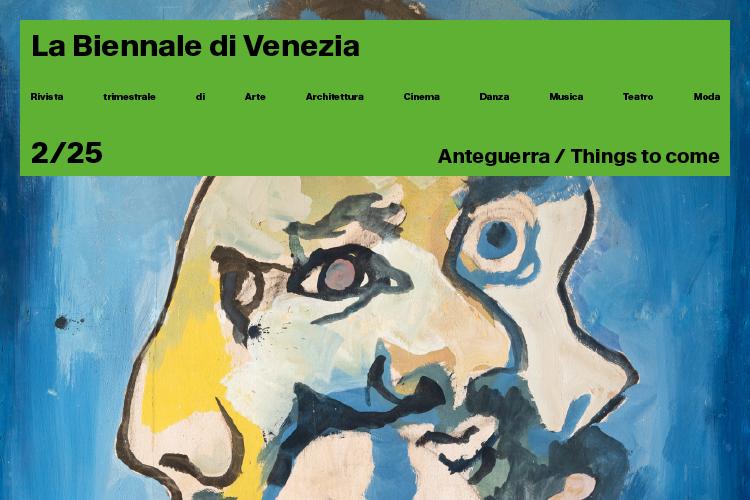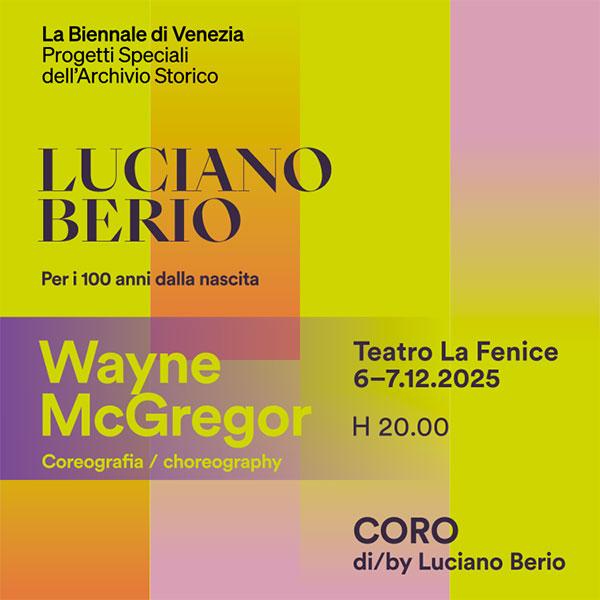Anteguerra / Things to come
n. 2 / 2025

“Anteguerra / Things to come”: the third issue of the Biennale Magazine
The historic Magazine published by La Biennale di Venezia, brought back to life after fifty-three years of editorial silence.
Anteguerra / Things to come
Anteguerra / Things to come is the title of issue number 2/2025 of the historic Magazine published by La Biennale di Venezia, brought back to life after fifty-three years of editorial silence. The new issue was presented at the Salone Internazionale del Libro in Turin on Thursday 16 May, at stand T143 in the Oval Pavilion. The publication was introduced by Debora Rossi, Editor-in-chief of the Magazine, with the members of the editorial staff. On this occasion, visitors were invited to discover the most recent releases in the Edizioni La Biennale di Venezia catalogue.
Each issue contains original and exclusive articles, testimonies, interviews, dialogues and contributions by artists, scholars and leading Italian and international figures in culture and civil society. The Magazine is characterised by the multiplicity of languages and freedom of expression it cultivates, allowing ample space for experimentation in graphic design and a cross-fertilisation between different forms and codes.
Conceived and produced exclusively in print, the Magazine features a significant iconographic apparatus that draws largely from the Historical Archive of La Biennale and from national and international photographic research. Published quarterly, each issue will be monographic in focus, establishing a dialogue between the disciplines that distinguish La Biennale di Venezia – visual arts, architecture, dance, music, theatre, cinema – while also venturing into the realms of science and literature.
The cover is illustrated with a work by Mino Maccari: it is the image of a stage panel portraying a face and its reflections for the final parade in the opera The Comedy on the Bridge by Bohuslav Martinů at the Biennale Musica 1951 (tempera on plywood).
The contributions in issue 2/25 are by Christine Macel, Germaine Acogny, Roberto Cremascoli, Gianni Forte, Mazen Khaled, Luigi Gallo, Luca Francesconi, Antonio Marras, Darco Pellos e Wael Shawky, Josep Oriol Esteve, Claudio Magris, Robert Jan van Pelt, Mizue Hasegawa, Annarita Colombo, Jon Padfield, Javier Cercas, Gohar Dashti, Balakrishnan Rajagopal, Anita Likmeta, Valentina Tanni, Silvano Tagliagambe, Felix Azhimov, Giovanni Caprara, Cinzia Zuffada, Pier Luigi Sacco, Matt Leacock, Krystian Lupa, Stefania Vitulli, Alexander Sokurov, Denis Brotto, Mark Salvatus.
The issue is illustrated with photographic images from: Biennale Archive; Fototeca Cinema; Sfeir-Semler Gallery; Lisson Gallery; Lia Rumma; Barakat Contemporary; Museo Nacional del Prado; Scala, Firenze; New Picture Library; Summerfield Press; Carlo Valsecchi; Collezione Maramotti; Elvert Bañares; National Commission for Culture and the Arts NCCA – Philippine Arts in Venice PAVB. It also features photographs by Stefano Graziani, Junpei Katayama e Jon Padfield, Carlo Valsecchi, Gohar Dashti, Luca Capuano, Lorenzo Pesce, Gabrielle Traversat, Toni Fabris, Joan Fontcuberta, Jason Larkin, Masahisa Fukase.
Editorial board
The editor-in-chief of the magazine is Debora Rossi. The director is journalist and author Luigi Mascheroni. The Editorial team consists the Office of Editorial Activities, the Press Offices and a team of professionals from the various Departments of La Biennale. The graphic design is by Tomo Tomo, a communication design firm founded in Milan by Davide Di Gennaro and Luca Pitoni.
Distribution
The magazine is on sale in La Biennale’s online store and in major bookstores. It will be presented in various locations and events in Italy and abroad.
Historical notes
The Biennale di Venezia magazine 1950-1971
In consideration of the great success of the XXIV International Art Exhibition of La Biennale in 1948, the first after the end of World War II, the Institution decided in the early months of 1950 to publish a magazine with the intent to make it the official organ for the promotion of its events. The idea was to create a quarterly magazine titled ‘La Biennale di Venezia’. The cover image varied for each issue in relation to the activities of La Biennale, and from the very outset the magazine appeared as a precious object, printed in a large format, and highly refined from an editorial point of view: it featured inserts on different types and weights of paper, with many sophisticated images, mostly in black and white, but with some colour plates that increased in number over time. The initial title was: “La Biennale di Venezia. Quarterly magazine of art cinema music theatre fashion”. The inaugural issue was launched in July 1950 and consisted of 50 pages of text, 5 colour plates and 65 plates in black and white. The publisher was Vittorio Alfieri, Florence; the printer, Carlo Ferrari, Venice. The Editorial Board consisted of the President of the La Biennale Giovanni Ponti, the Secretary General Rodolfo Pallucchini, the editor-in-chief of the magazine was Elio Zorzi (head of the Press Office) who relied on the following collaborators: Umbro Apollonio (head of ASAC), Antonio Petrucci, Giovanni Piccini, Adolfo Zajotti, Ferdinando Ballo.
Second phase of the magazine 1960-1971
The double issue number 36/37 July-December 1959 was the last in a phase of transition. Pallucchini had left his position at La Biennale in 1957 and been replaced by Gian Alberto Dall’Acqua. Apollonio took over the magazine as editor-in-chief, and was officially appointed to the position in 1958, working from the start in close understanding with Vladimiro Dorigo. The less-academic orientation introduced by Apollonio tended to give space to the concerns of the art of the new generations, further updating the magazine’s look to make it less slick. The turnabout became evident starting with issue number 40 July-September 1960: the font was changed again, the number of critical contributions increased, the images were mostly in black and white.
The new policy sought to give “ample margin to the most pressing criticism in a union of formal, historical and aesthetic aspects which today’s global art proposes and develops”. It was also decided that the magazine would be published in-house by La Biennale, without involving other more or less renowned publishers, due to the lackluster sales. This editorial policy remained in force through the 1970s, when after 1975 the publication of the magazine was replaced by that of the Annuari directed by Dorigo.


